Nestle's Quality Management: Identifying Issues & Improvement Plan
VerifiedAdded on 2023/04/25
|13
|3340
|221
Essay
AI Summary
This essay provides an overview of quality management issues at Nestle Australia Ltd, analyzing the causes and impacts of these issues, such as the Good Start 2 infant formula recall, unethical marketing of baby formula in developing nations, the Chinese milk scandal, and the Maggi ban in India. It explores the underlying causes, including mineral deficiencies, lack of consumer knowledge, melamine contamination, and excessive levels of MSG and lead. The essay then proposes several quality management strategies to improve Nestle's performance, including Six Sigma for precise ingredient control, the Plan-Do-Study-Act (PDCA) cycle for continuous improvement, Root Cause Analysis to prevent failures, and Benchmarking to compare performance against competitors. The implementation of these strategies aims to enhance product quality, brand image, customer loyalty, and overall organizational success.
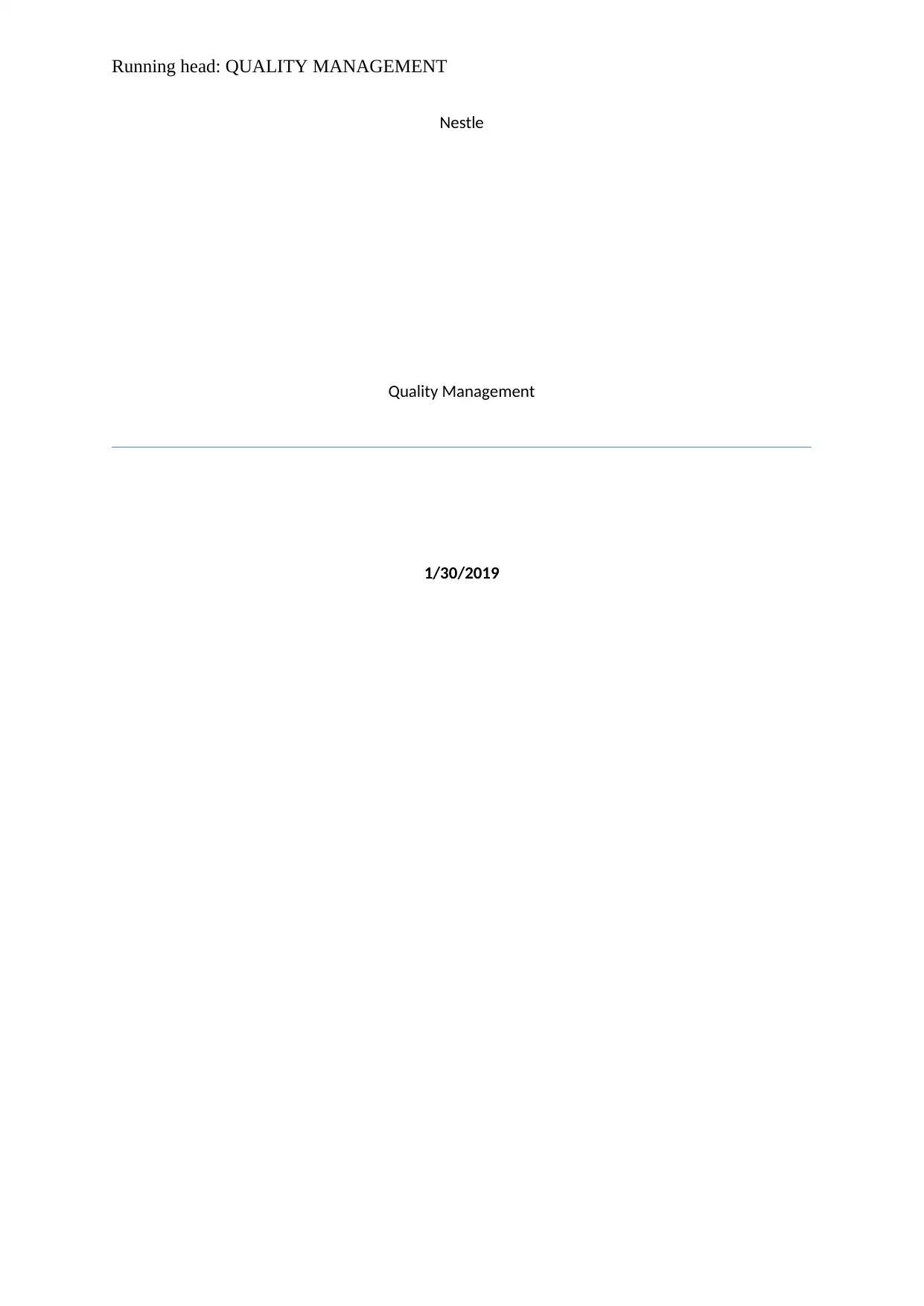
Running head: QUALITY MANAGEMENT
Nestle
Quality Management
1/30/2019
Nestle
Quality Management
1/30/2019
Paraphrase This Document
Need a fresh take? Get an instant paraphrase of this document with our AI Paraphraser
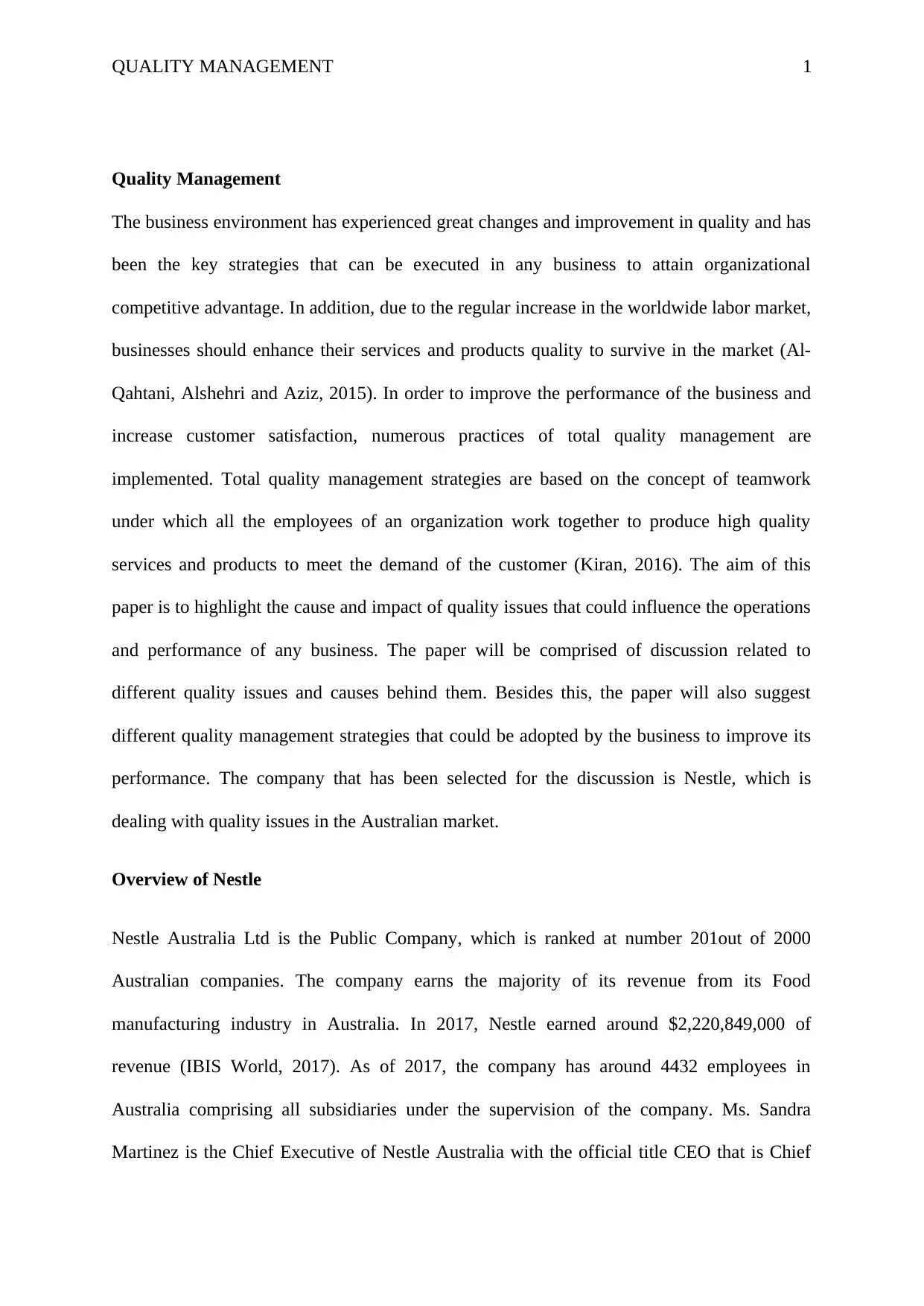
QUALITY MANAGEMENT 1
Quality Management
The business environment has experienced great changes and improvement in quality and has
been the key strategies that can be executed in any business to attain organizational
competitive advantage. In addition, due to the regular increase in the worldwide labor market,
businesses should enhance their services and products quality to survive in the market (Al-
Qahtani, Alshehri and Aziz, 2015). In order to improve the performance of the business and
increase customer satisfaction, numerous practices of total quality management are
implemented. Total quality management strategies are based on the concept of teamwork
under which all the employees of an organization work together to produce high quality
services and products to meet the demand of the customer (Kiran, 2016). The aim of this
paper is to highlight the cause and impact of quality issues that could influence the operations
and performance of any business. The paper will be comprised of discussion related to
different quality issues and causes behind them. Besides this, the paper will also suggest
different quality management strategies that could be adopted by the business to improve its
performance. The company that has been selected for the discussion is Nestle, which is
dealing with quality issues in the Australian market.
Overview of Nestle
Nestle Australia Ltd is the Public Company, which is ranked at number 201out of 2000
Australian companies. The company earns the majority of its revenue from its Food
manufacturing industry in Australia. In 2017, Nestle earned around $2,220,849,000 of
revenue (IBIS World, 2017). As of 2017, the company has around 4432 employees in
Australia comprising all subsidiaries under the supervision of the company. Ms. Sandra
Martinez is the Chief Executive of Nestle Australia with the official title CEO that is Chief
Quality Management
The business environment has experienced great changes and improvement in quality and has
been the key strategies that can be executed in any business to attain organizational
competitive advantage. In addition, due to the regular increase in the worldwide labor market,
businesses should enhance their services and products quality to survive in the market (Al-
Qahtani, Alshehri and Aziz, 2015). In order to improve the performance of the business and
increase customer satisfaction, numerous practices of total quality management are
implemented. Total quality management strategies are based on the concept of teamwork
under which all the employees of an organization work together to produce high quality
services and products to meet the demand of the customer (Kiran, 2016). The aim of this
paper is to highlight the cause and impact of quality issues that could influence the operations
and performance of any business. The paper will be comprised of discussion related to
different quality issues and causes behind them. Besides this, the paper will also suggest
different quality management strategies that could be adopted by the business to improve its
performance. The company that has been selected for the discussion is Nestle, which is
dealing with quality issues in the Australian market.
Overview of Nestle
Nestle Australia Ltd is the Public Company, which is ranked at number 201out of 2000
Australian companies. The company earns the majority of its revenue from its Food
manufacturing industry in Australia. In 2017, Nestle earned around $2,220,849,000 of
revenue (IBIS World, 2017). As of 2017, the company has around 4432 employees in
Australia comprising all subsidiaries under the supervision of the company. Ms. Sandra
Martinez is the Chief Executive of Nestle Australia with the official title CEO that is Chief
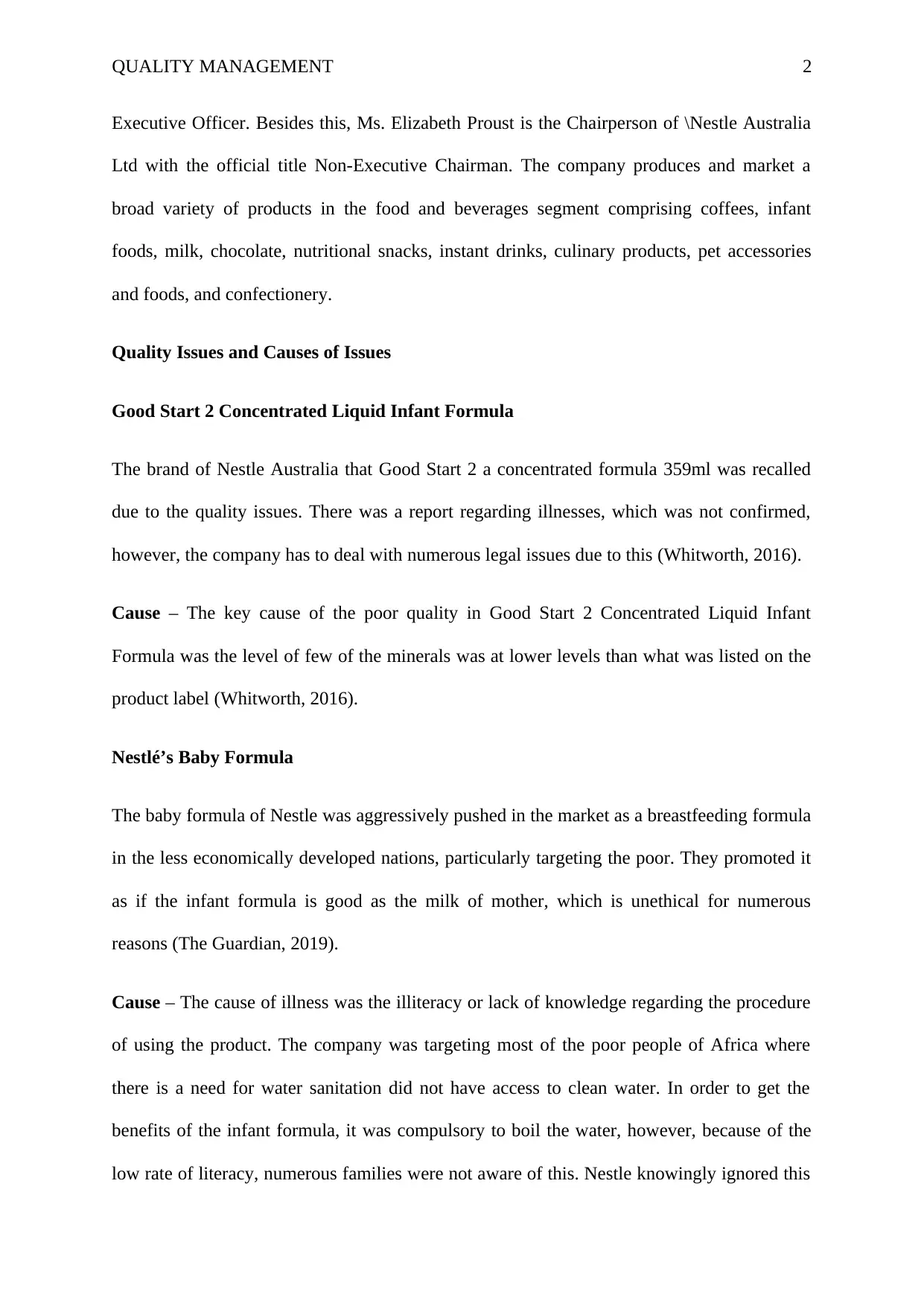
QUALITY MANAGEMENT 2
Executive Officer. Besides this, Ms. Elizabeth Proust is the Chairperson of \Nestle Australia
Ltd with the official title Non-Executive Chairman. The company produces and market a
broad variety of products in the food and beverages segment comprising coffees, infant
foods, milk, chocolate, nutritional snacks, instant drinks, culinary products, pet accessories
and foods, and confectionery.
Quality Issues and Causes of Issues
Good Start 2 Concentrated Liquid Infant Formula
The brand of Nestle Australia that Good Start 2 a concentrated formula 359ml was recalled
due to the quality issues. There was a report regarding illnesses, which was not confirmed,
however, the company has to deal with numerous legal issues due to this (Whitworth, 2016).
Cause – The key cause of the poor quality in Good Start 2 Concentrated Liquid Infant
Formula was the level of few of the minerals was at lower levels than what was listed on the
product label (Whitworth, 2016).
Nestlé’s Baby Formula
The baby formula of Nestle was aggressively pushed in the market as a breastfeeding formula
in the less economically developed nations, particularly targeting the poor. They promoted it
as if the infant formula is good as the milk of mother, which is unethical for numerous
reasons (The Guardian, 2019).
Cause – The cause of illness was the illiteracy or lack of knowledge regarding the procedure
of using the product. The company was targeting most of the poor people of Africa where
there is a need for water sanitation did not have access to clean water. In order to get the
benefits of the infant formula, it was compulsory to boil the water, however, because of the
low rate of literacy, numerous families were not aware of this. Nestle knowingly ignored this
Executive Officer. Besides this, Ms. Elizabeth Proust is the Chairperson of \Nestle Australia
Ltd with the official title Non-Executive Chairman. The company produces and market a
broad variety of products in the food and beverages segment comprising coffees, infant
foods, milk, chocolate, nutritional snacks, instant drinks, culinary products, pet accessories
and foods, and confectionery.
Quality Issues and Causes of Issues
Good Start 2 Concentrated Liquid Infant Formula
The brand of Nestle Australia that Good Start 2 a concentrated formula 359ml was recalled
due to the quality issues. There was a report regarding illnesses, which was not confirmed,
however, the company has to deal with numerous legal issues due to this (Whitworth, 2016).
Cause – The key cause of the poor quality in Good Start 2 Concentrated Liquid Infant
Formula was the level of few of the minerals was at lower levels than what was listed on the
product label (Whitworth, 2016).
Nestlé’s Baby Formula
The baby formula of Nestle was aggressively pushed in the market as a breastfeeding formula
in the less economically developed nations, particularly targeting the poor. They promoted it
as if the infant formula is good as the milk of mother, which is unethical for numerous
reasons (The Guardian, 2019).
Cause – The cause of illness was the illiteracy or lack of knowledge regarding the procedure
of using the product. The company was targeting most of the poor people of Africa where
there is a need for water sanitation did not have access to clean water. In order to get the
benefits of the infant formula, it was compulsory to boil the water, however, because of the
low rate of literacy, numerous families were not aware of this. Nestle knowingly ignored this
⊘ This is a preview!⊘
Do you want full access?
Subscribe today to unlock all pages.

Trusted by 1+ million students worldwide
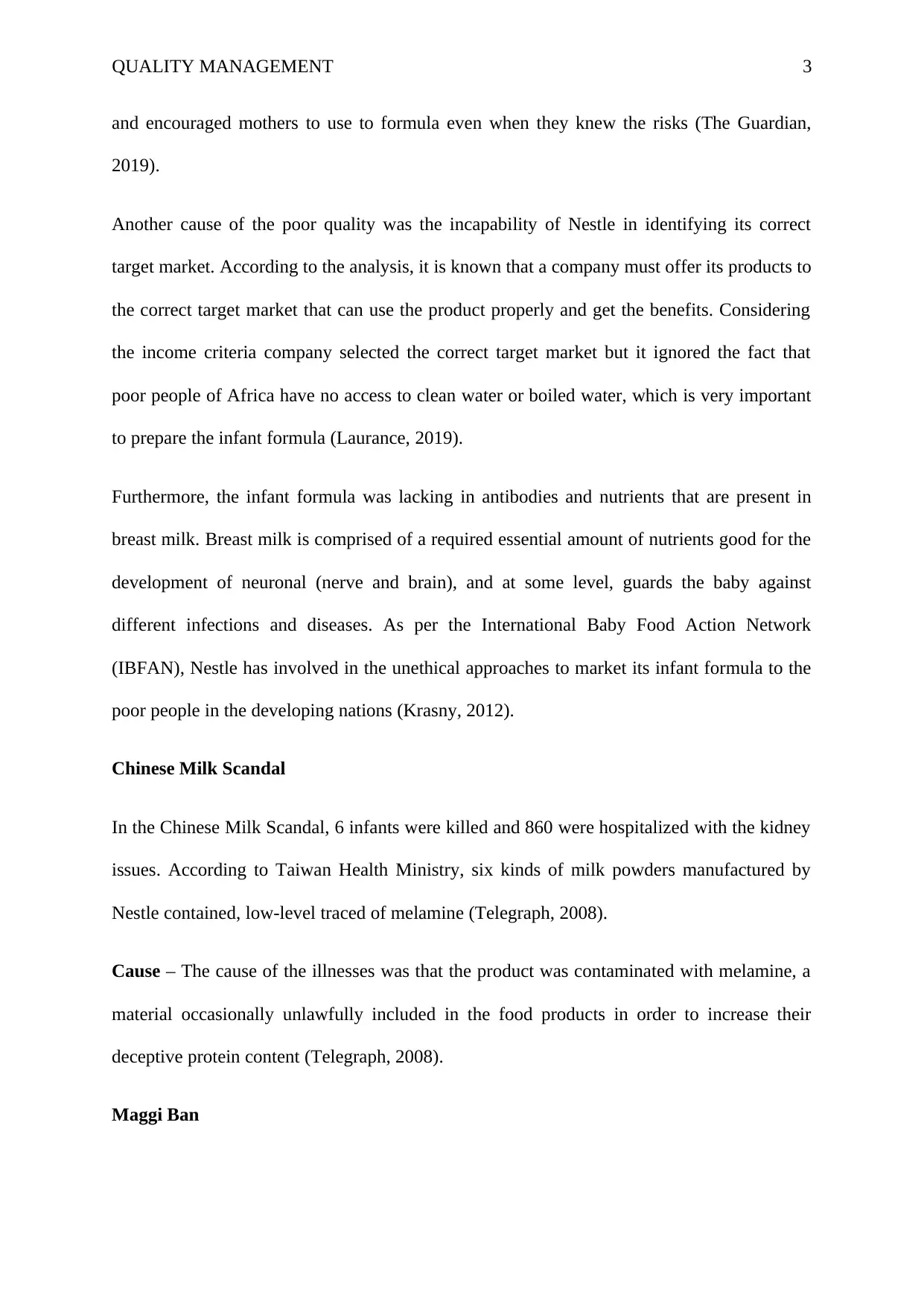
QUALITY MANAGEMENT 3
and encouraged mothers to use to formula even when they knew the risks (The Guardian,
2019).
Another cause of the poor quality was the incapability of Nestle in identifying its correct
target market. According to the analysis, it is known that a company must offer its products to
the correct target market that can use the product properly and get the benefits. Considering
the income criteria company selected the correct target market but it ignored the fact that
poor people of Africa have no access to clean water or boiled water, which is very important
to prepare the infant formula (Laurance, 2019).
Furthermore, the infant formula was lacking in antibodies and nutrients that are present in
breast milk. Breast milk is comprised of a required essential amount of nutrients good for the
development of neuronal (nerve and brain), and at some level, guards the baby against
different infections and diseases. As per the International Baby Food Action Network
(IBFAN), Nestle has involved in the unethical approaches to market its infant formula to the
poor people in the developing nations (Krasny, 2012).
Chinese Milk Scandal
In the Chinese Milk Scandal, 6 infants were killed and 860 were hospitalized with the kidney
issues. According to Taiwan Health Ministry, six kinds of milk powders manufactured by
Nestle contained, low-level traced of melamine (Telegraph, 2008).
Cause – The cause of the illnesses was that the product was contaminated with melamine, a
material occasionally unlawfully included in the food products in order to increase their
deceptive protein content (Telegraph, 2008).
Maggi Ban
and encouraged mothers to use to formula even when they knew the risks (The Guardian,
2019).
Another cause of the poor quality was the incapability of Nestle in identifying its correct
target market. According to the analysis, it is known that a company must offer its products to
the correct target market that can use the product properly and get the benefits. Considering
the income criteria company selected the correct target market but it ignored the fact that
poor people of Africa have no access to clean water or boiled water, which is very important
to prepare the infant formula (Laurance, 2019).
Furthermore, the infant formula was lacking in antibodies and nutrients that are present in
breast milk. Breast milk is comprised of a required essential amount of nutrients good for the
development of neuronal (nerve and brain), and at some level, guards the baby against
different infections and diseases. As per the International Baby Food Action Network
(IBFAN), Nestle has involved in the unethical approaches to market its infant formula to the
poor people in the developing nations (Krasny, 2012).
Chinese Milk Scandal
In the Chinese Milk Scandal, 6 infants were killed and 860 were hospitalized with the kidney
issues. According to Taiwan Health Ministry, six kinds of milk powders manufactured by
Nestle contained, low-level traced of melamine (Telegraph, 2008).
Cause – The cause of the illnesses was that the product was contaminated with melamine, a
material occasionally unlawfully included in the food products in order to increase their
deceptive protein content (Telegraph, 2008).
Maggi Ban
Paraphrase This Document
Need a fresh take? Get an instant paraphrase of this document with our AI Paraphraser
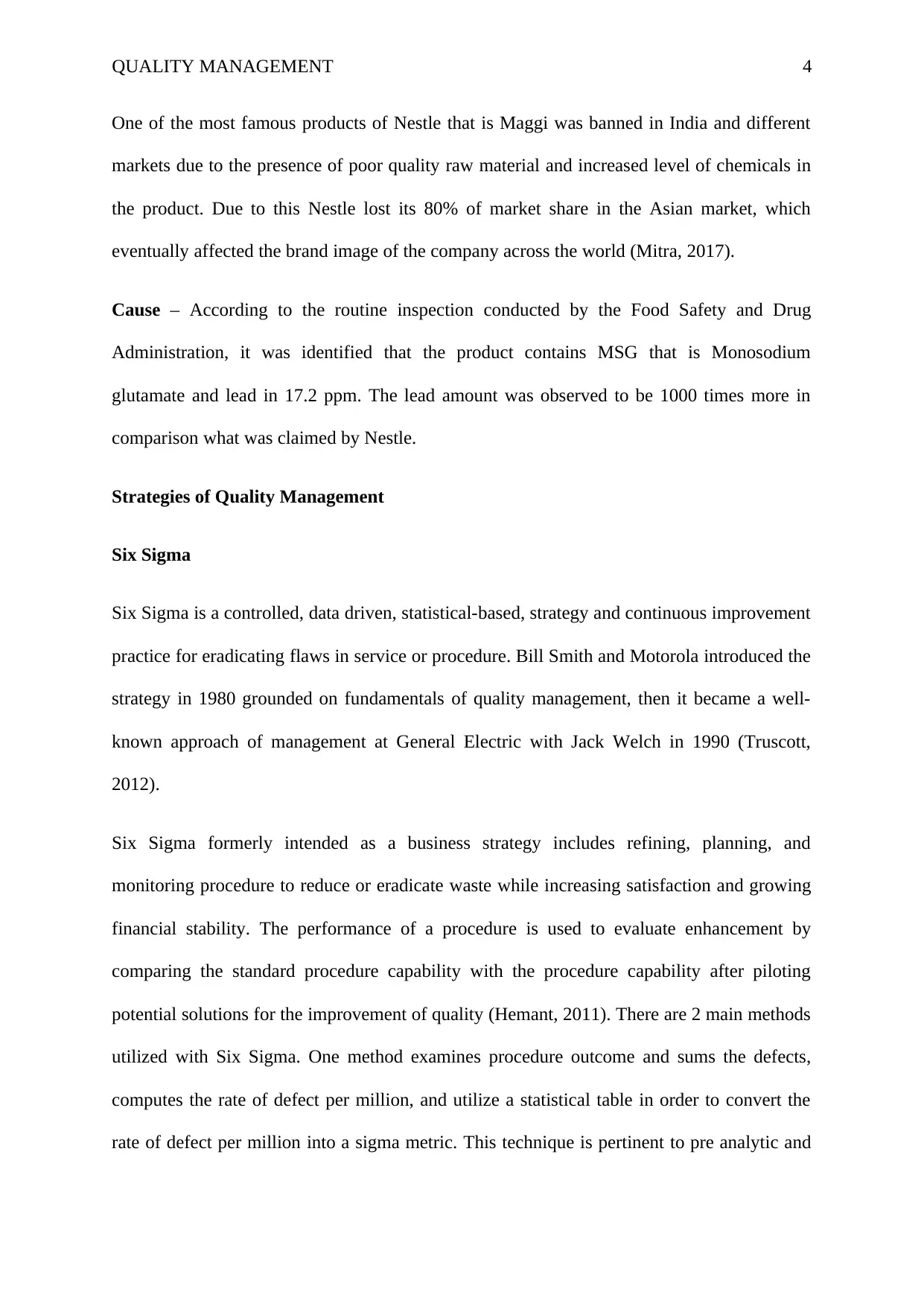
QUALITY MANAGEMENT 4
One of the most famous products of Nestle that is Maggi was banned in India and different
markets due to the presence of poor quality raw material and increased level of chemicals in
the product. Due to this Nestle lost its 80% of market share in the Asian market, which
eventually affected the brand image of the company across the world (Mitra, 2017).
Cause – According to the routine inspection conducted by the Food Safety and Drug
Administration, it was identified that the product contains MSG that is Monosodium
glutamate and lead in 17.2 ppm. The lead amount was observed to be 1000 times more in
comparison what was claimed by Nestle.
Strategies of Quality Management
Six Sigma
Six Sigma is a controlled, data driven, statistical-based, strategy and continuous improvement
practice for eradicating flaws in service or procedure. Bill Smith and Motorola introduced the
strategy in 1980 grounded on fundamentals of quality management, then it became a well-
known approach of management at General Electric with Jack Welch in 1990 (Truscott,
2012).
Six Sigma formerly intended as a business strategy includes refining, planning, and
monitoring procedure to reduce or eradicate waste while increasing satisfaction and growing
financial stability. The performance of a procedure is used to evaluate enhancement by
comparing the standard procedure capability with the procedure capability after piloting
potential solutions for the improvement of quality (Hemant, 2011). There are 2 main methods
utilized with Six Sigma. One method examines procedure outcome and sums the defects,
computes the rate of defect per million, and utilize a statistical table in order to convert the
rate of defect per million into a sigma metric. This technique is pertinent to pre analytic and
One of the most famous products of Nestle that is Maggi was banned in India and different
markets due to the presence of poor quality raw material and increased level of chemicals in
the product. Due to this Nestle lost its 80% of market share in the Asian market, which
eventually affected the brand image of the company across the world (Mitra, 2017).
Cause – According to the routine inspection conducted by the Food Safety and Drug
Administration, it was identified that the product contains MSG that is Monosodium
glutamate and lead in 17.2 ppm. The lead amount was observed to be 1000 times more in
comparison what was claimed by Nestle.
Strategies of Quality Management
Six Sigma
Six Sigma is a controlled, data driven, statistical-based, strategy and continuous improvement
practice for eradicating flaws in service or procedure. Bill Smith and Motorola introduced the
strategy in 1980 grounded on fundamentals of quality management, then it became a well-
known approach of management at General Electric with Jack Welch in 1990 (Truscott,
2012).
Six Sigma formerly intended as a business strategy includes refining, planning, and
monitoring procedure to reduce or eradicate waste while increasing satisfaction and growing
financial stability. The performance of a procedure is used to evaluate enhancement by
comparing the standard procedure capability with the procedure capability after piloting
potential solutions for the improvement of quality (Hemant, 2011). There are 2 main methods
utilized with Six Sigma. One method examines procedure outcome and sums the defects,
computes the rate of defect per million, and utilize a statistical table in order to convert the
rate of defect per million into a sigma metric. This technique is pertinent to pre analytic and
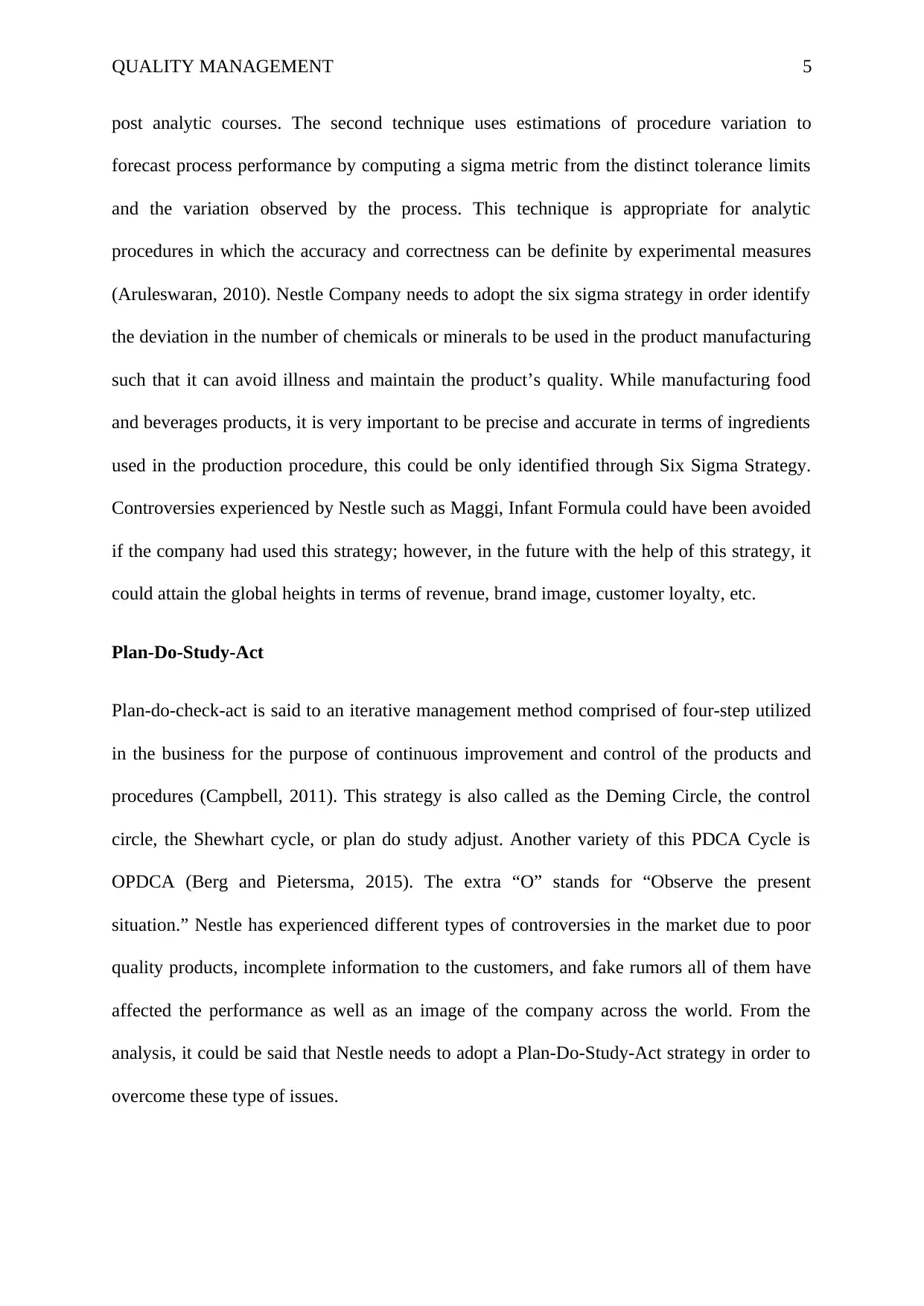
QUALITY MANAGEMENT 5
post analytic courses. The second technique uses estimations of procedure variation to
forecast process performance by computing a sigma metric from the distinct tolerance limits
and the variation observed by the process. This technique is appropriate for analytic
procedures in which the accuracy and correctness can be definite by experimental measures
(Aruleswaran, 2010). Nestle Company needs to adopt the six sigma strategy in order identify
the deviation in the number of chemicals or minerals to be used in the product manufacturing
such that it can avoid illness and maintain the product’s quality. While manufacturing food
and beverages products, it is very important to be precise and accurate in terms of ingredients
used in the production procedure, this could be only identified through Six Sigma Strategy.
Controversies experienced by Nestle such as Maggi, Infant Formula could have been avoided
if the company had used this strategy; however, in the future with the help of this strategy, it
could attain the global heights in terms of revenue, brand image, customer loyalty, etc.
Plan-Do-Study-Act
Plan-do-check-act is said to an iterative management method comprised of four-step utilized
in the business for the purpose of continuous improvement and control of the products and
procedures (Campbell, 2011). This strategy is also called as the Deming Circle, the control
circle, the Shewhart cycle, or plan do study adjust. Another variety of this PDCA Cycle is
OPDCA (Berg and Pietersma, 2015). The extra “O” stands for “Observe the present
situation.” Nestle has experienced different types of controversies in the market due to poor
quality products, incomplete information to the customers, and fake rumors all of them have
affected the performance as well as an image of the company across the world. From the
analysis, it could be said that Nestle needs to adopt a Plan-Do-Study-Act strategy in order to
overcome these type of issues.
post analytic courses. The second technique uses estimations of procedure variation to
forecast process performance by computing a sigma metric from the distinct tolerance limits
and the variation observed by the process. This technique is appropriate for analytic
procedures in which the accuracy and correctness can be definite by experimental measures
(Aruleswaran, 2010). Nestle Company needs to adopt the six sigma strategy in order identify
the deviation in the number of chemicals or minerals to be used in the product manufacturing
such that it can avoid illness and maintain the product’s quality. While manufacturing food
and beverages products, it is very important to be precise and accurate in terms of ingredients
used in the production procedure, this could be only identified through Six Sigma Strategy.
Controversies experienced by Nestle such as Maggi, Infant Formula could have been avoided
if the company had used this strategy; however, in the future with the help of this strategy, it
could attain the global heights in terms of revenue, brand image, customer loyalty, etc.
Plan-Do-Study-Act
Plan-do-check-act is said to an iterative management method comprised of four-step utilized
in the business for the purpose of continuous improvement and control of the products and
procedures (Campbell, 2011). This strategy is also called as the Deming Circle, the control
circle, the Shewhart cycle, or plan do study adjust. Another variety of this PDCA Cycle is
OPDCA (Berg and Pietersma, 2015). The extra “O” stands for “Observe the present
situation.” Nestle has experienced different types of controversies in the market due to poor
quality products, incomplete information to the customers, and fake rumors all of them have
affected the performance as well as an image of the company across the world. From the
analysis, it could be said that Nestle needs to adopt a Plan-Do-Study-Act strategy in order to
overcome these type of issues.
⊘ This is a preview!⊘
Do you want full access?
Subscribe today to unlock all pages.

Trusted by 1+ million students worldwide
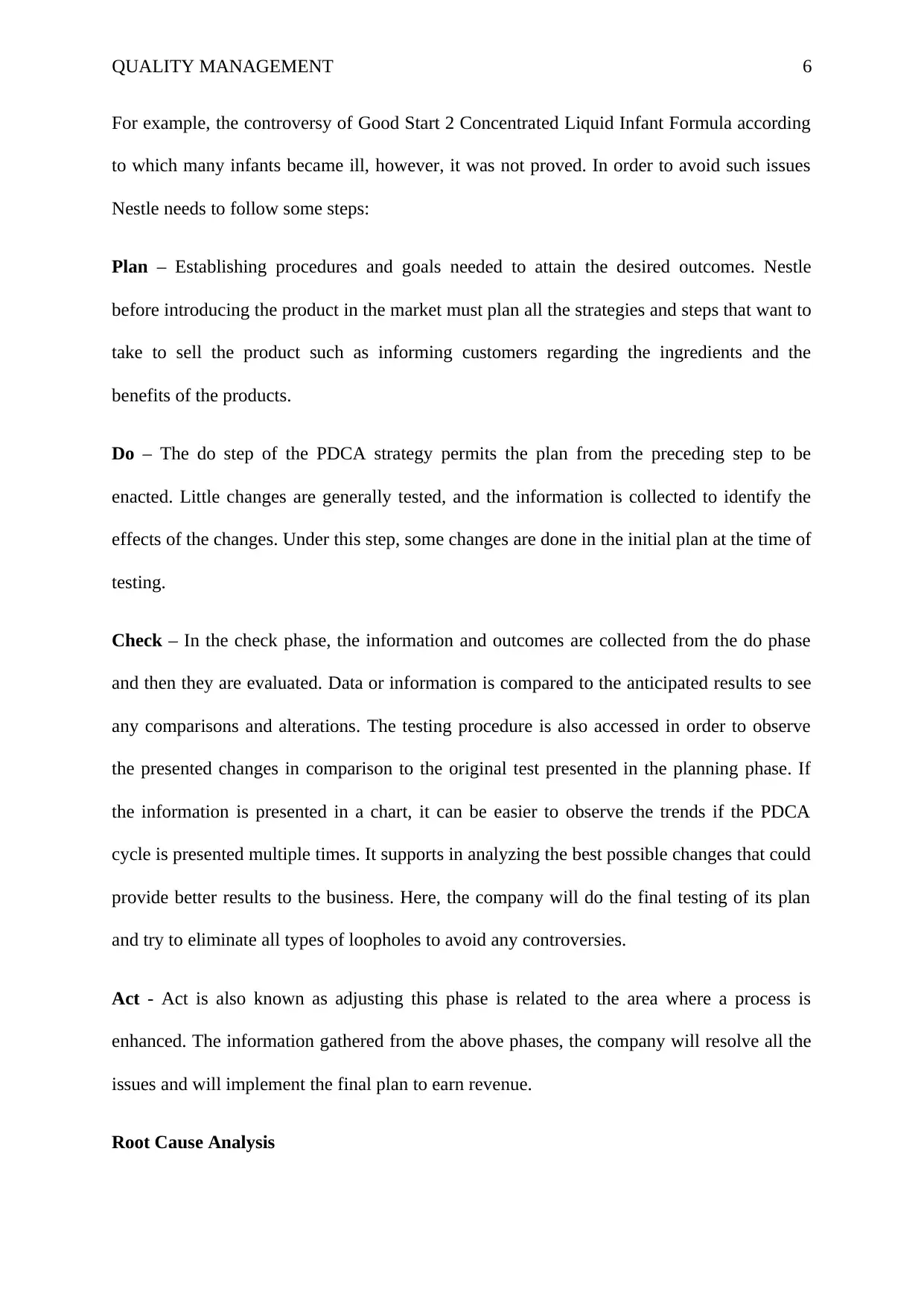
QUALITY MANAGEMENT 6
For example, the controversy of Good Start 2 Concentrated Liquid Infant Formula according
to which many infants became ill, however, it was not proved. In order to avoid such issues
Nestle needs to follow some steps:
Plan – Establishing procedures and goals needed to attain the desired outcomes. Nestle
before introducing the product in the market must plan all the strategies and steps that want to
take to sell the product such as informing customers regarding the ingredients and the
benefits of the products.
Do – The do step of the PDCA strategy permits the plan from the preceding step to be
enacted. Little changes are generally tested, and the information is collected to identify the
effects of the changes. Under this step, some changes are done in the initial plan at the time of
testing.
Check – In the check phase, the information and outcomes are collected from the do phase
and then they are evaluated. Data or information is compared to the anticipated results to see
any comparisons and alterations. The testing procedure is also accessed in order to observe
the presented changes in comparison to the original test presented in the planning phase. If
the information is presented in a chart, it can be easier to observe the trends if the PDCA
cycle is presented multiple times. It supports in analyzing the best possible changes that could
provide better results to the business. Here, the company will do the final testing of its plan
and try to eliminate all types of loopholes to avoid any controversies.
Act - Act is also known as adjusting this phase is related to the area where a process is
enhanced. The information gathered from the above phases, the company will resolve all the
issues and will implement the final plan to earn revenue.
Root Cause Analysis
For example, the controversy of Good Start 2 Concentrated Liquid Infant Formula according
to which many infants became ill, however, it was not proved. In order to avoid such issues
Nestle needs to follow some steps:
Plan – Establishing procedures and goals needed to attain the desired outcomes. Nestle
before introducing the product in the market must plan all the strategies and steps that want to
take to sell the product such as informing customers regarding the ingredients and the
benefits of the products.
Do – The do step of the PDCA strategy permits the plan from the preceding step to be
enacted. Little changes are generally tested, and the information is collected to identify the
effects of the changes. Under this step, some changes are done in the initial plan at the time of
testing.
Check – In the check phase, the information and outcomes are collected from the do phase
and then they are evaluated. Data or information is compared to the anticipated results to see
any comparisons and alterations. The testing procedure is also accessed in order to observe
the presented changes in comparison to the original test presented in the planning phase. If
the information is presented in a chart, it can be easier to observe the trends if the PDCA
cycle is presented multiple times. It supports in analyzing the best possible changes that could
provide better results to the business. Here, the company will do the final testing of its plan
and try to eliminate all types of loopholes to avoid any controversies.
Act - Act is also known as adjusting this phase is related to the area where a process is
enhanced. The information gathered from the above phases, the company will resolve all the
issues and will implement the final plan to earn revenue.
Root Cause Analysis
Paraphrase This Document
Need a fresh take? Get an instant paraphrase of this document with our AI Paraphraser
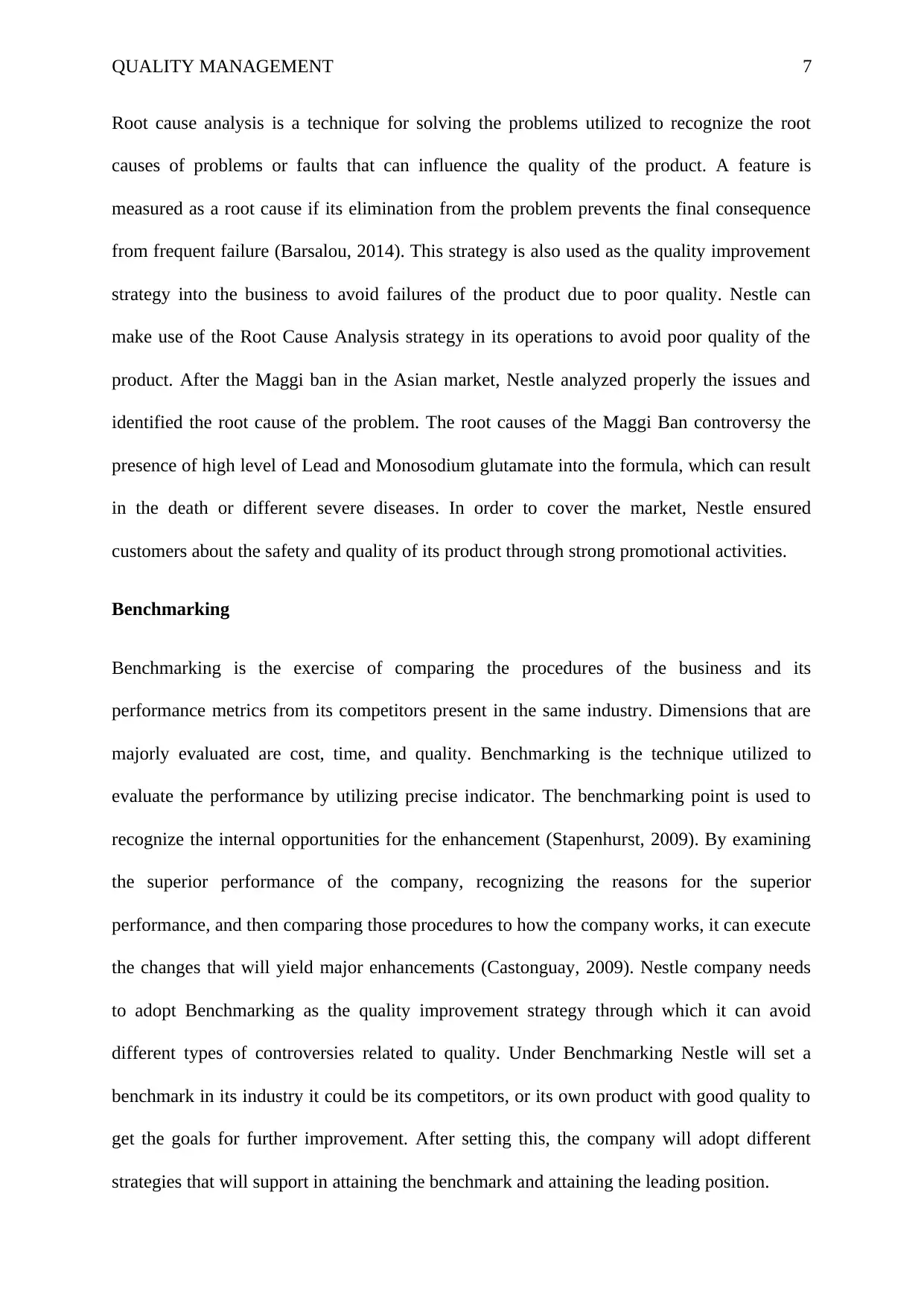
QUALITY MANAGEMENT 7
Root cause analysis is a technique for solving the problems utilized to recognize the root
causes of problems or faults that can influence the quality of the product. A feature is
measured as a root cause if its elimination from the problem prevents the final consequence
from frequent failure (Barsalou, 2014). This strategy is also used as the quality improvement
strategy into the business to avoid failures of the product due to poor quality. Nestle can
make use of the Root Cause Analysis strategy in its operations to avoid poor quality of the
product. After the Maggi ban in the Asian market, Nestle analyzed properly the issues and
identified the root cause of the problem. The root causes of the Maggi Ban controversy the
presence of high level of Lead and Monosodium glutamate into the formula, which can result
in the death or different severe diseases. In order to cover the market, Nestle ensured
customers about the safety and quality of its product through strong promotional activities.
Benchmarking
Benchmarking is the exercise of comparing the procedures of the business and its
performance metrics from its competitors present in the same industry. Dimensions that are
majorly evaluated are cost, time, and quality. Benchmarking is the technique utilized to
evaluate the performance by utilizing precise indicator. The benchmarking point is used to
recognize the internal opportunities for the enhancement (Stapenhurst, 2009). By examining
the superior performance of the company, recognizing the reasons for the superior
performance, and then comparing those procedures to how the company works, it can execute
the changes that will yield major enhancements (Castonguay, 2009). Nestle company needs
to adopt Benchmarking as the quality improvement strategy through which it can avoid
different types of controversies related to quality. Under Benchmarking Nestle will set a
benchmark in its industry it could be its competitors, or its own product with good quality to
get the goals for further improvement. After setting this, the company will adopt different
strategies that will support in attaining the benchmark and attaining the leading position.
Root cause analysis is a technique for solving the problems utilized to recognize the root
causes of problems or faults that can influence the quality of the product. A feature is
measured as a root cause if its elimination from the problem prevents the final consequence
from frequent failure (Barsalou, 2014). This strategy is also used as the quality improvement
strategy into the business to avoid failures of the product due to poor quality. Nestle can
make use of the Root Cause Analysis strategy in its operations to avoid poor quality of the
product. After the Maggi ban in the Asian market, Nestle analyzed properly the issues and
identified the root cause of the problem. The root causes of the Maggi Ban controversy the
presence of high level of Lead and Monosodium glutamate into the formula, which can result
in the death or different severe diseases. In order to cover the market, Nestle ensured
customers about the safety and quality of its product through strong promotional activities.
Benchmarking
Benchmarking is the exercise of comparing the procedures of the business and its
performance metrics from its competitors present in the same industry. Dimensions that are
majorly evaluated are cost, time, and quality. Benchmarking is the technique utilized to
evaluate the performance by utilizing precise indicator. The benchmarking point is used to
recognize the internal opportunities for the enhancement (Stapenhurst, 2009). By examining
the superior performance of the company, recognizing the reasons for the superior
performance, and then comparing those procedures to how the company works, it can execute
the changes that will yield major enhancements (Castonguay, 2009). Nestle company needs
to adopt Benchmarking as the quality improvement strategy through which it can avoid
different types of controversies related to quality. Under Benchmarking Nestle will set a
benchmark in its industry it could be its competitors, or its own product with good quality to
get the goals for further improvement. After setting this, the company will adopt different
strategies that will support in attaining the benchmark and attaining the leading position.
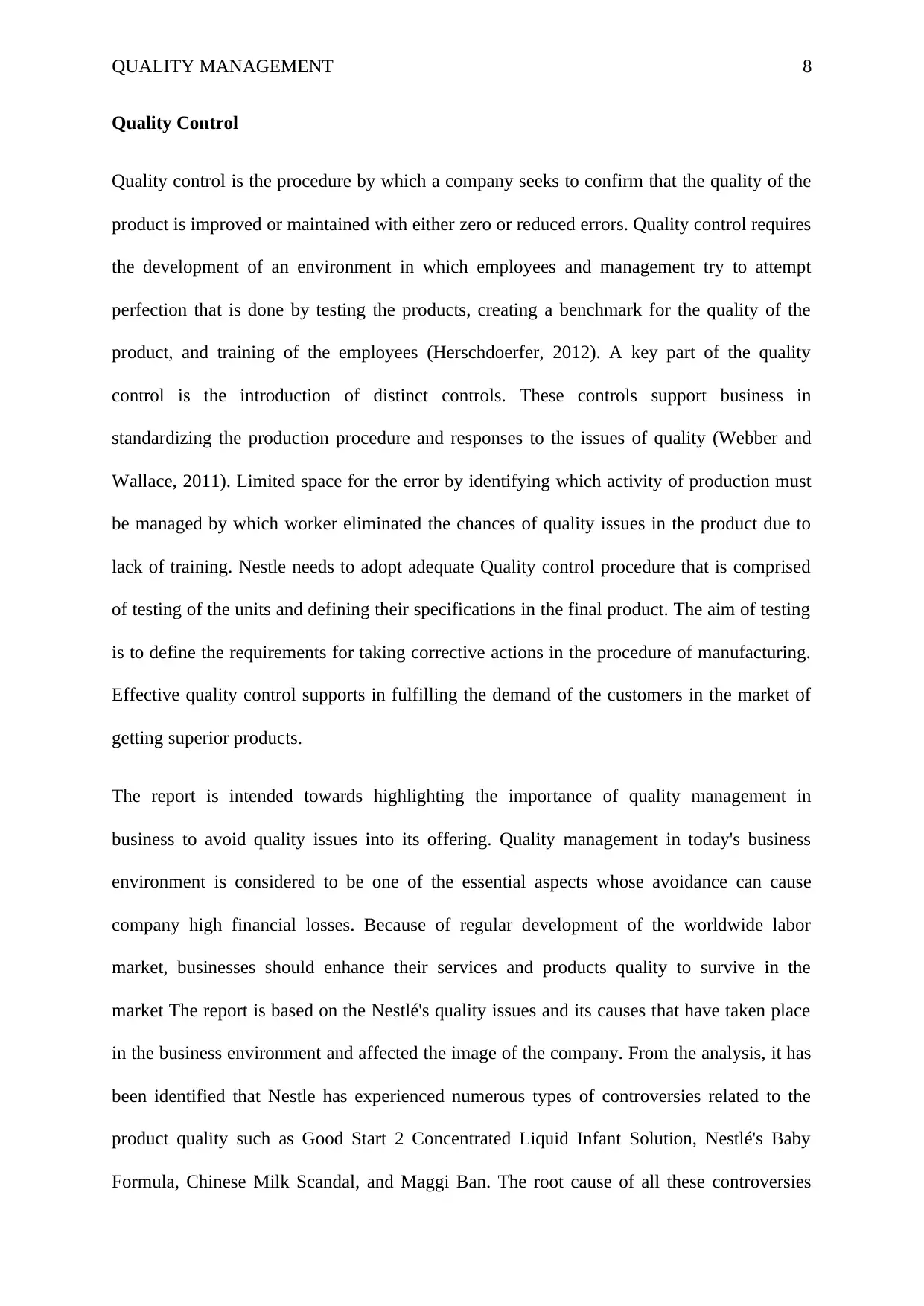
QUALITY MANAGEMENT 8
Quality Control
Quality control is the procedure by which a company seeks to confirm that the quality of the
product is improved or maintained with either zero or reduced errors. Quality control requires
the development of an environment in which employees and management try to attempt
perfection that is done by testing the products, creating a benchmark for the quality of the
product, and training of the employees (Herschdoerfer, 2012). A key part of the quality
control is the introduction of distinct controls. These controls support business in
standardizing the production procedure and responses to the issues of quality (Webber and
Wallace, 2011). Limited space for the error by identifying which activity of production must
be managed by which worker eliminated the chances of quality issues in the product due to
lack of training. Nestle needs to adopt adequate Quality control procedure that is comprised
of testing of the units and defining their specifications in the final product. The aim of testing
is to define the requirements for taking corrective actions in the procedure of manufacturing.
Effective quality control supports in fulfilling the demand of the customers in the market of
getting superior products.
The report is intended towards highlighting the importance of quality management in
business to avoid quality issues into its offering. Quality management in today's business
environment is considered to be one of the essential aspects whose avoidance can cause
company high financial losses. Because of regular development of the worldwide labor
market, businesses should enhance their services and products quality to survive in the
market The report is based on the Nestlé's quality issues and its causes that have taken place
in the business environment and affected the image of the company. From the analysis, it has
been identified that Nestle has experienced numerous types of controversies related to the
product quality such as Good Start 2 Concentrated Liquid Infant Solution, Nestlé's Baby
Formula, Chinese Milk Scandal, and Maggi Ban. The root cause of all these controversies
Quality Control
Quality control is the procedure by which a company seeks to confirm that the quality of the
product is improved or maintained with either zero or reduced errors. Quality control requires
the development of an environment in which employees and management try to attempt
perfection that is done by testing the products, creating a benchmark for the quality of the
product, and training of the employees (Herschdoerfer, 2012). A key part of the quality
control is the introduction of distinct controls. These controls support business in
standardizing the production procedure and responses to the issues of quality (Webber and
Wallace, 2011). Limited space for the error by identifying which activity of production must
be managed by which worker eliminated the chances of quality issues in the product due to
lack of training. Nestle needs to adopt adequate Quality control procedure that is comprised
of testing of the units and defining their specifications in the final product. The aim of testing
is to define the requirements for taking corrective actions in the procedure of manufacturing.
Effective quality control supports in fulfilling the demand of the customers in the market of
getting superior products.
The report is intended towards highlighting the importance of quality management in
business to avoid quality issues into its offering. Quality management in today's business
environment is considered to be one of the essential aspects whose avoidance can cause
company high financial losses. Because of regular development of the worldwide labor
market, businesses should enhance their services and products quality to survive in the
market The report is based on the Nestlé's quality issues and its causes that have taken place
in the business environment and affected the image of the company. From the analysis, it has
been identified that Nestle has experienced numerous types of controversies related to the
product quality such as Good Start 2 Concentrated Liquid Infant Solution, Nestlé's Baby
Formula, Chinese Milk Scandal, and Maggi Ban. The root cause of all these controversies
⊘ This is a preview!⊘
Do you want full access?
Subscribe today to unlock all pages.

Trusted by 1+ million students worldwide
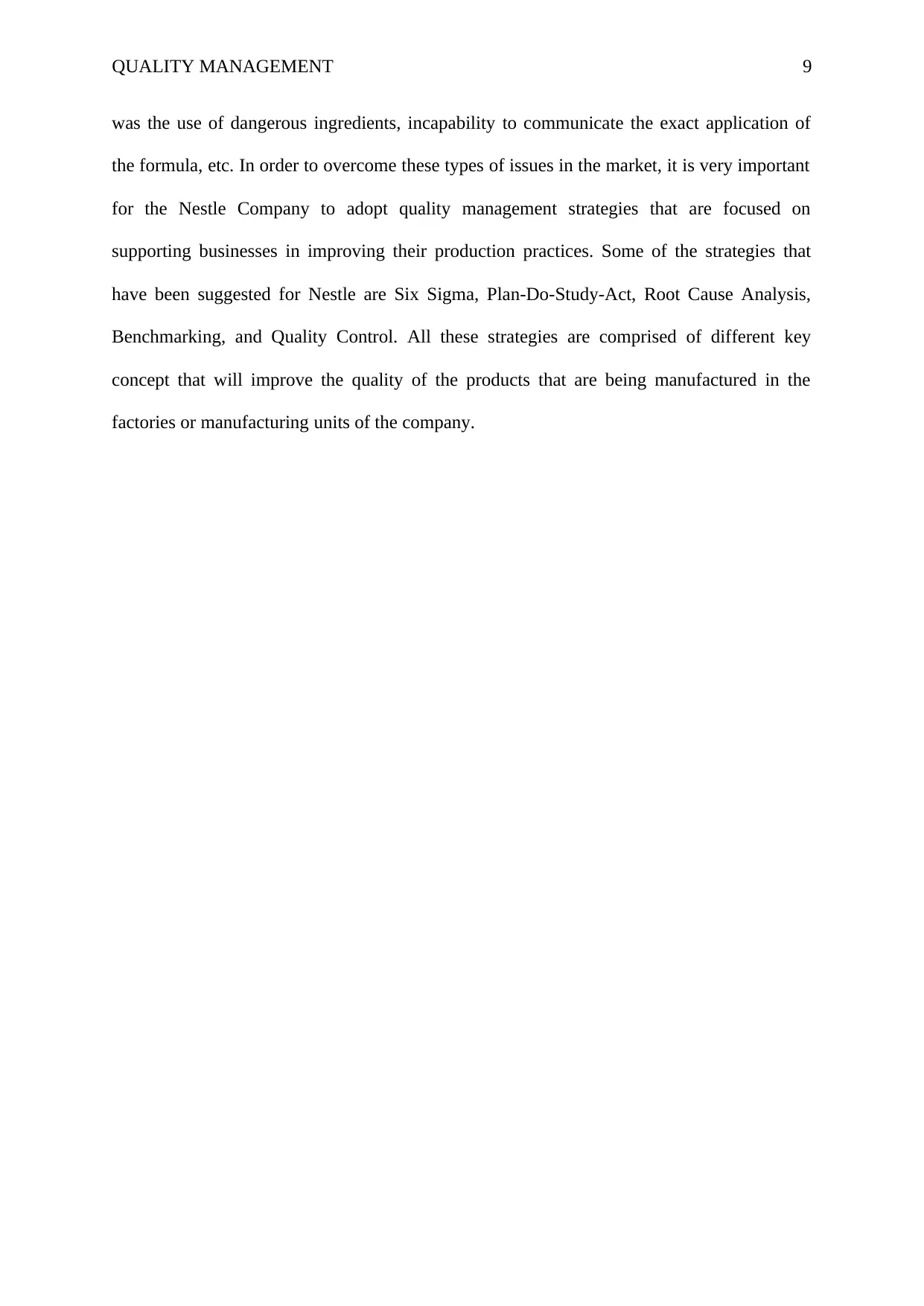
QUALITY MANAGEMENT 9
was the use of dangerous ingredients, incapability to communicate the exact application of
the formula, etc. In order to overcome these types of issues in the market, it is very important
for the Nestle Company to adopt quality management strategies that are focused on
supporting businesses in improving their production practices. Some of the strategies that
have been suggested for Nestle are Six Sigma, Plan-Do-Study-Act, Root Cause Analysis,
Benchmarking, and Quality Control. All these strategies are comprised of different key
concept that will improve the quality of the products that are being manufactured in the
factories or manufacturing units of the company.
was the use of dangerous ingredients, incapability to communicate the exact application of
the formula, etc. In order to overcome these types of issues in the market, it is very important
for the Nestle Company to adopt quality management strategies that are focused on
supporting businesses in improving their production practices. Some of the strategies that
have been suggested for Nestle are Six Sigma, Plan-Do-Study-Act, Root Cause Analysis,
Benchmarking, and Quality Control. All these strategies are comprised of different key
concept that will improve the quality of the products that are being manufactured in the
factories or manufacturing units of the company.
Paraphrase This Document
Need a fresh take? Get an instant paraphrase of this document with our AI Paraphraser
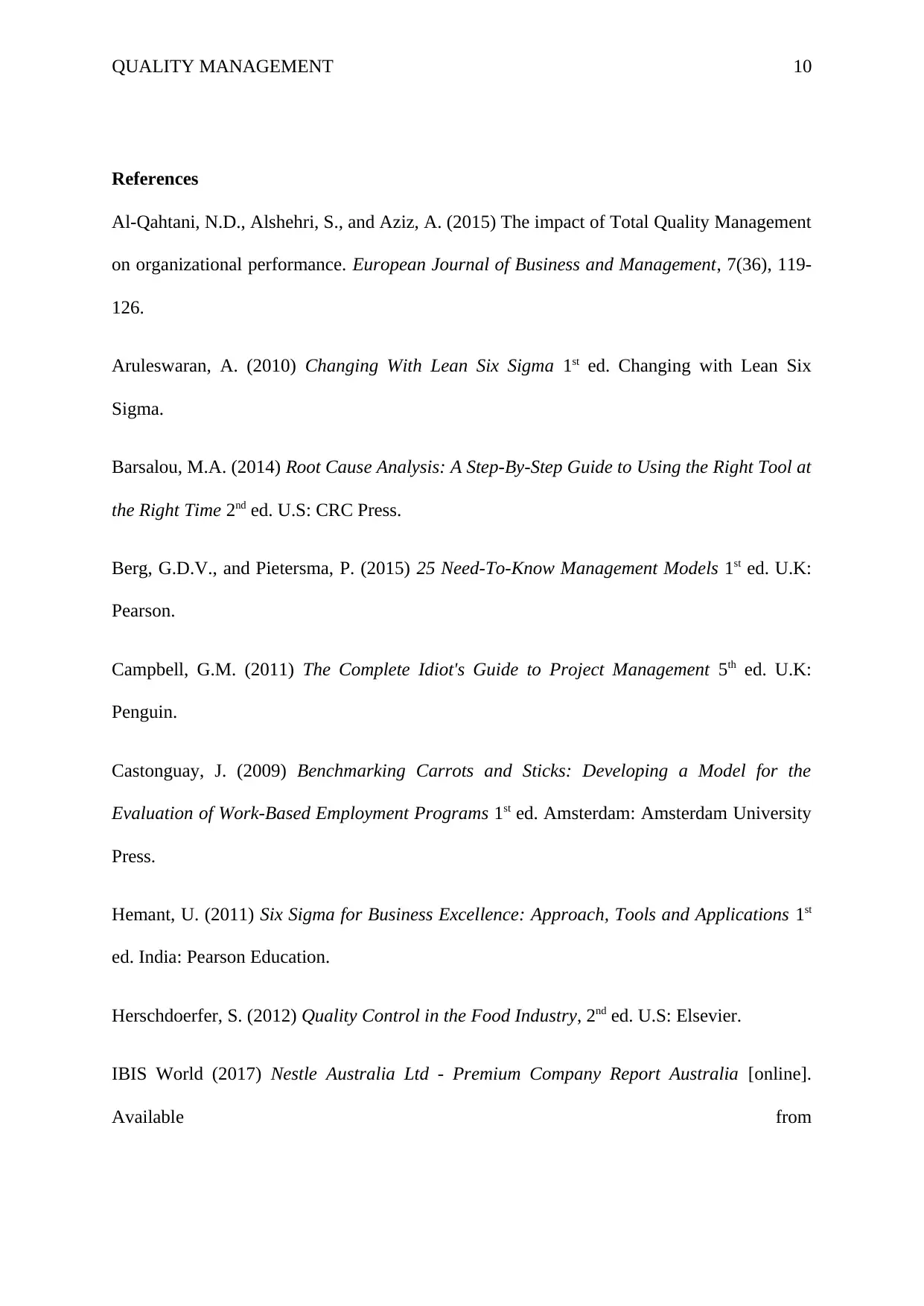
QUALITY MANAGEMENT 10
References
Al-Qahtani, N.D., Alshehri, S., and Aziz, A. (2015) The impact of Total Quality Management
on organizational performance. European Journal of Business and Management, 7(36), 119-
126.
Aruleswaran, A. (2010) Changing With Lean Six Sigma 1st ed. Changing with Lean Six
Sigma.
Barsalou, M.A. (2014) Root Cause Analysis: A Step-By-Step Guide to Using the Right Tool at
the Right Time 2nd ed. U.S: CRC Press.
Berg, G.D.V., and Pietersma, P. (2015) 25 Need-To-Know Management Models 1st ed. U.K:
Pearson.
Campbell, G.M. (2011) The Complete Idiot's Guide to Project Management 5th ed. U.K:
Penguin.
Castonguay, J. (2009) Benchmarking Carrots and Sticks: Developing a Model for the
Evaluation of Work-Based Employment Programs 1st ed. Amsterdam: Amsterdam University
Press.
Hemant, U. (2011) Six Sigma for Business Excellence: Approach, Tools and Applications 1st
ed. India: Pearson Education.
Herschdoerfer, S. (2012) Quality Control in the Food Industry, 2nd ed. U.S: Elsevier.
IBIS World (2017) Nestle Australia Ltd - Premium Company Report Australia [online].
Available from
References
Al-Qahtani, N.D., Alshehri, S., and Aziz, A. (2015) The impact of Total Quality Management
on organizational performance. European Journal of Business and Management, 7(36), 119-
126.
Aruleswaran, A. (2010) Changing With Lean Six Sigma 1st ed. Changing with Lean Six
Sigma.
Barsalou, M.A. (2014) Root Cause Analysis: A Step-By-Step Guide to Using the Right Tool at
the Right Time 2nd ed. U.S: CRC Press.
Berg, G.D.V., and Pietersma, P. (2015) 25 Need-To-Know Management Models 1st ed. U.K:
Pearson.
Campbell, G.M. (2011) The Complete Idiot's Guide to Project Management 5th ed. U.K:
Penguin.
Castonguay, J. (2009) Benchmarking Carrots and Sticks: Developing a Model for the
Evaluation of Work-Based Employment Programs 1st ed. Amsterdam: Amsterdam University
Press.
Hemant, U. (2011) Six Sigma for Business Excellence: Approach, Tools and Applications 1st
ed. India: Pearson Education.
Herschdoerfer, S. (2012) Quality Control in the Food Industry, 2nd ed. U.S: Elsevier.
IBIS World (2017) Nestle Australia Ltd - Premium Company Report Australia [online].
Available from
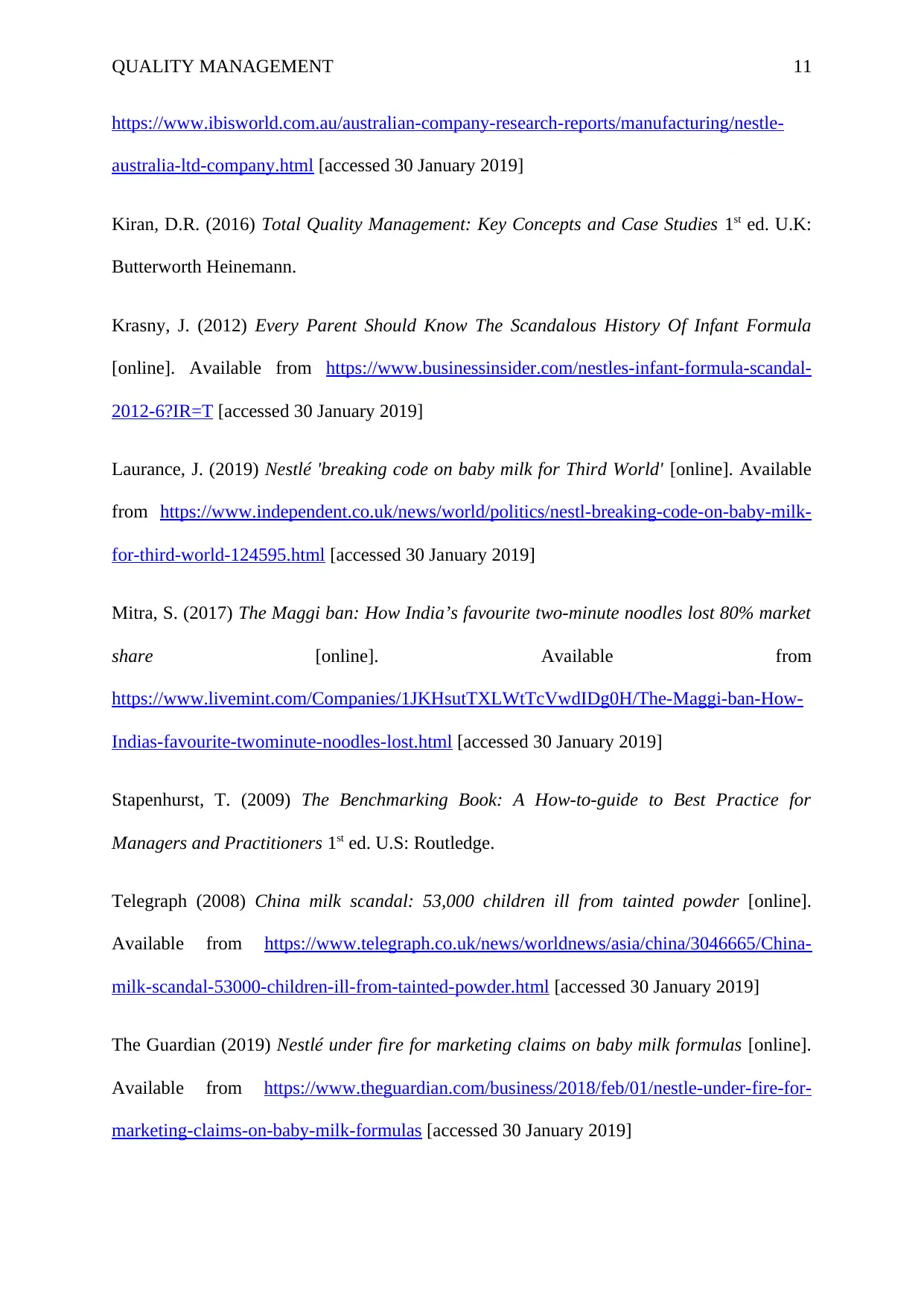
QUALITY MANAGEMENT 11
https://www.ibisworld.com.au/australian-company-research-reports/manufacturing/nestle-
australia-ltd-company.html [accessed 30 January 2019]
Kiran, D.R. (2016) Total Quality Management: Key Concepts and Case Studies 1st ed. U.K:
Butterworth Heinemann.
Krasny, J. (2012) Every Parent Should Know The Scandalous History Of Infant Formula
[online]. Available from https://www.businessinsider.com/nestles-infant-formula-scandal-
2012-6?IR=T [accessed 30 January 2019]
Laurance, J. (2019) Nestlé 'breaking code on baby milk for Third World' [online]. Available
from https://www.independent.co.uk/news/world/politics/nestl-breaking-code-on-baby-milk-
for-third-world-124595.html [accessed 30 January 2019]
Mitra, S. (2017) The Maggi ban: How India’s favourite two-minute noodles lost 80% market
share [online]. Available from
https://www.livemint.com/Companies/1JKHsutTXLWtTcVwdIDg0H/The-Maggi-ban-How-
Indias-favourite-twominute-noodles-lost.html [accessed 30 January 2019]
Stapenhurst, T. (2009) The Benchmarking Book: A How-to-guide to Best Practice for
Managers and Practitioners 1st ed. U.S: Routledge.
Telegraph (2008) China milk scandal: 53,000 children ill from tainted powder [online].
Available from https://www.telegraph.co.uk/news/worldnews/asia/china/3046665/China-
milk-scandal-53000-children-ill-from-tainted-powder.html [accessed 30 January 2019]
The Guardian (2019) Nestlé under fire for marketing claims on baby milk formulas [online].
Available from https://www.theguardian.com/business/2018/feb/01/nestle-under-fire-for-
marketing-claims-on-baby-milk-formulas [accessed 30 January 2019]
https://www.ibisworld.com.au/australian-company-research-reports/manufacturing/nestle-
australia-ltd-company.html [accessed 30 January 2019]
Kiran, D.R. (2016) Total Quality Management: Key Concepts and Case Studies 1st ed. U.K:
Butterworth Heinemann.
Krasny, J. (2012) Every Parent Should Know The Scandalous History Of Infant Formula
[online]. Available from https://www.businessinsider.com/nestles-infant-formula-scandal-
2012-6?IR=T [accessed 30 January 2019]
Laurance, J. (2019) Nestlé 'breaking code on baby milk for Third World' [online]. Available
from https://www.independent.co.uk/news/world/politics/nestl-breaking-code-on-baby-milk-
for-third-world-124595.html [accessed 30 January 2019]
Mitra, S. (2017) The Maggi ban: How India’s favourite two-minute noodles lost 80% market
share [online]. Available from
https://www.livemint.com/Companies/1JKHsutTXLWtTcVwdIDg0H/The-Maggi-ban-How-
Indias-favourite-twominute-noodles-lost.html [accessed 30 January 2019]
Stapenhurst, T. (2009) The Benchmarking Book: A How-to-guide to Best Practice for
Managers and Practitioners 1st ed. U.S: Routledge.
Telegraph (2008) China milk scandal: 53,000 children ill from tainted powder [online].
Available from https://www.telegraph.co.uk/news/worldnews/asia/china/3046665/China-
milk-scandal-53000-children-ill-from-tainted-powder.html [accessed 30 January 2019]
The Guardian (2019) Nestlé under fire for marketing claims on baby milk formulas [online].
Available from https://www.theguardian.com/business/2018/feb/01/nestle-under-fire-for-
marketing-claims-on-baby-milk-formulas [accessed 30 January 2019]
⊘ This is a preview!⊘
Do you want full access?
Subscribe today to unlock all pages.

Trusted by 1+ million students worldwide
1 out of 13
Related Documents
Your All-in-One AI-Powered Toolkit for Academic Success.
+13062052269
info@desklib.com
Available 24*7 on WhatsApp / Email
![[object Object]](/_next/static/media/star-bottom.7253800d.svg)
Unlock your academic potential
Copyright © 2020–2025 A2Z Services. All Rights Reserved. Developed and managed by ZUCOL.





